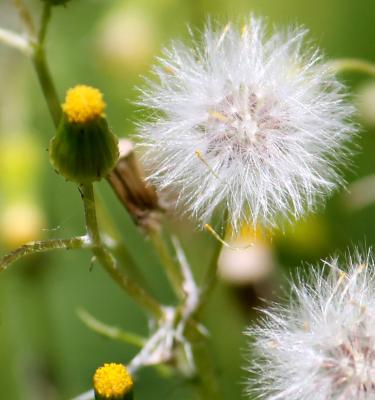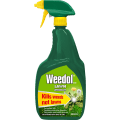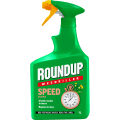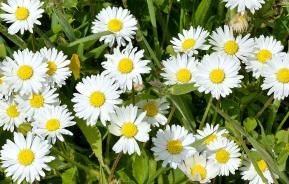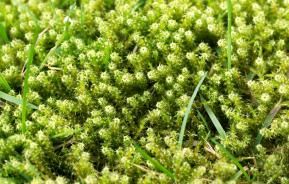Wondering how to get rid of weeds in your lawn and borders? Weeds are plants that are growing anywhere you don’t want them to, and they can be a real headache for gardeners, spoiling the look of our lawns and competing with plants for water and nutrients. This guide shows you how to identify lawn and garden weeds, plus tips on how to weed lawns and borders to keep them weed-free.
Many weeds can be dealt with easily using weedkiller. When using weedkiller to deal with especially tough weed problems, always follow the instructions carefully to keep both yourself and your plants safe!
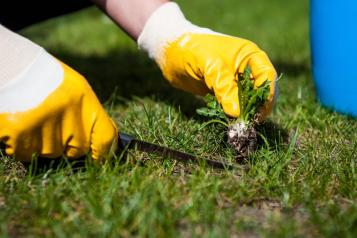
Common lawn weeds
A problem most gardeners face at some stage is how to remove weeds from the lawn. The good news is that it is possible to kill weeds without killing the grass as well. Using a combination of natural weed treatments for lawns, which control weeds by improving lawn health, plus selective lawn weedkillers, that won’t damage your grass, to tackle the tougher weeds, will help you achieve the weed-free lawn of your dreams!
Dandelions
Dandelions (Taraxacum officinale) are a childhood favourite with their bright yellow flowers and puffballs of white feathery seeds. Dandelion flowers are an excellent food source for bees in spring, and goldfinches love to eat the fluffy seeds. However, they self-seed prolifically and will quickly colonise bare patches of soil. The flat rosettes of leaves with their serrated edges can smother grass in lawns. Dandelions have very long tap roots which break easily, and the plants can grow back from any root segments left in the ground.
Dandelion is a very common perennial weed and one that can be surprisingly hard to get rid of because it germinates throughout the year. You can recognise it from its teeth-shaped leaves, which form in a rosette, and multiple yellow flowers that grow from its centre. You most commonly see them from March to November.

How to get rid of dandelions in the lawn
- Regular lawn maintenance encourages the growth of a thick healthy lawn which gives weeds less chance of taking root. Give your lawn a boost with Miracle-Grow Complete 4 in1, which controls lawn weeds and gives you a thick green lawn in weeks.
- Tackle individual dandelions in the lawn with a selective weedkiller in a handheld spray such as Weedol Gun! Lawn Weedkiller.
Creeping buttercup
Creeping buttercup (Ranunculus repens) is a common sight in damp grassland areas and often appears in lawns, producing bright yellow cup-shaped flowers from late spring to late summer above three-lobed hairy leaves. The flowers are very pollinator-friendly, providing food for bees and butterflies. However, creeping buttercup can spoil the look of a well-tended lawn, spreading by underground runners and forming large mats of foliage that crowd out the grass.
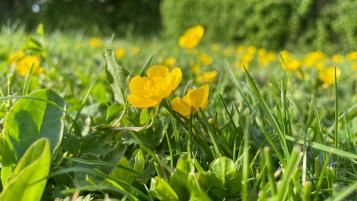
How to get rid of creeping buttercup in the lawn
- Creeping buttercup is more likely to take hold in damp or poorly draining soil. Aerate, scarify and top-dress your lawn annually to improve drainage and encourage the growth of strong healthy grass.
- Rake over any areas of creeping buttercup in the lawn before mowing. This raises the stems and foliage so that the mower blades can cut them, weakening the weed.
- Dig up individual weeds, taking care to remove any rooted sections of runner as well, as new plants will grow from these sections. Re-seed any areas of bare soil to avoid other weeds taking hold.
- Feed your lawn with Miracle-Gro Evergreen Natural 4 in 1 to encourage thick healthy grass and naturally prevent the growth of new weeds.
White clover, medick and bird’s foot trefoil
These three lawn weeds are all related and can look very similar. The simplest way to tell them apart is by their flowers and seeds. While clover flowers are very popular with pollinators, clover and related weeds can be a problem in lawns, competing with grass for water and nutrients.
White clover (Trifolium repens) is a perennial weed, well-known for its three-lobed leaves. It produces creamy white flowers from late spring to autumn. White clover spreads by underground stems (runners) as well as seed and can form large mats of leaves that smother grass in lawns.
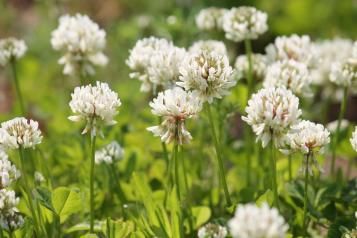
Black Medick (Medicago lupulina) is an annual or short-lived perennial with similar trefoil (three-lobed) leaves to clover, and rounded yellow flowers from spring to autumn, followed by black seed pods. It forms a low mat of stems and spreads by seed.
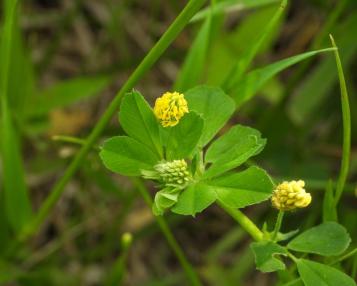
Bird's foot trefoil (Lotus corniculatus) is a perennial weed. It can be mistaken for medick, as it also has yellow flowers from mid-spring to autumn, but its leaves consist of five leaflets rather than three, with two leaflets near the base of the leaf stalk and the other three at the tip. The flowers are followed by distinctive long, thin seed pods.
_0.jpg)
How to get rid of white clover, medick and bird’s foot trefoil
As clover and its relatives are often resistant to many selective lawn weedkillers, the best way to control them is by non-chemical methods. Luckily, clover doesn’t compete well with healthy grass, so over time, you can get rid of clover in your lawn by regular annual lawn maintenance.
- Boost your lawn’s health by feeding it with Miracle-Gro Evergreen Natural 4 in 1 to encourage thick healthy grass and naturally prevent the growth of new weeds.
- Rake over areas of clover, medick or birds foot trefoil in the lawn before mowing so that the mower blades can cut the foliage and weaken the plants
- Dig out individual plants by hand using a hand fork, and re-seed bare patches to stop other weeds moving in.
Daisies
Daisies (Bellis perennis) are one of the easiest lawn weeds to recognise, with their familiar flowers boasting rays of white petals around yellow centres, above flat rosettes of oval leaves with scalloped edges. Daisies spread by both runners and seed, and can gradually form mats of foliage that smother grass.

How to get rid of daisies
- Dig up individual plants with a hand fork. Take care to remove the whole root, and re-seed bare patches.
- Use a selective lawn weedkiller such as Miracle-Gro Complete 4 in1.
- Target individual plants using a selective weedkiller in a handheld spray such as Weedol Gun! Lawn Weedkiller.
Plantains
The two most common plantains found in lawns are greater plantain (Plantago major) and ribwort plantain (Plantago lanceolata). Greater plantain has large oval leaves, while ribwort plantains have longer narrow leaves. In both plants the leaves have distinct veins running the length of leaves from the base, and both produce cone-shaped flowers on long stems. These are followed by seed pods that scatter large quantities of seed on the ground. Plantains compete with grass for water and nutrients, and their large leaves can smother areas of lawn.
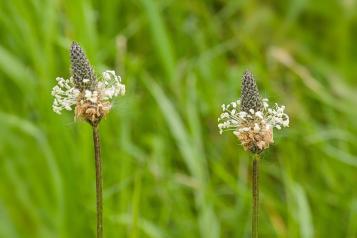
How to get rid of plantain
- Plantains have shallow, fibrous roots so can be dug up by hand using a hand fork.
- Tackle large areas of plantain with a selective weedkiller such as Miracle-Gro Complete 4 in 1.
- Annual lawn maintenance will keep your lawn healthy, making it harder for plantains and other weeds to establish.
Common mouse-ear chickweed
Mouse-ear chickweed (Cerastium fontanum) is a low, creeping lawn weed with small oval leaves on thin stems and small white flowers which can appear from mid spring well into autumn. The creeping stems root when they touch soil, gradually forming dense mats of foliage that crowd out the lawn grass. Mouse-ear chickweed is more common in shady lawns and damp areas.

How to get rid of mouse-ear chickweed in your lawn
- Aerate your lawn annually as part of your lawn maintenance routine. This will improve lawn health, making it harder for mouse-ear chickweed to spread.
- Feed your lawn with Miracle-Gro Evergreen Natural 4 in 1 to encourage thick healthy grass and naturally prevent the growth of new weeds.
- Dig up small patches of mouse-ear chickweed by hand using a hand fork.
Yarrow
Yarrow (Achillea millefolium) is a native wildflower with ferny foliage and flat-topped pinkish white flowerheads on upright stems. It spreads by seed and by underground rhizomes and quickly forms mats of foliage that can smother grass. Yarrow is a resilient plant, and often appears in lawns on dry or nutrient-poor soils chalk where it can out-compete the grass.
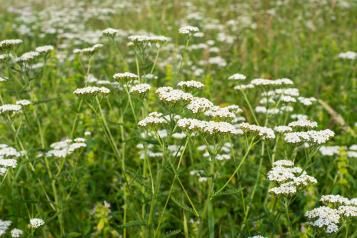
How to get rid of yarrow in your lawn
- Dig out individual plants using a hand fork.
- Yarrow is resistant to many weedkillers, but applications of Miracle-Gro Complete 4 in 1 can help to control it, as well as boosting lawn growth.
Common garden weeds
Weeds in borders are often best tackled by hand to avoid damage to surrounding plants. If you need to use weedkiller to tackle especially tough garden weeds, remember to cover all neighbouring plants with plastic sheeting to protect them, and always follow the manufacturer’s instructions.
Creeping thistle
You’re unlikely to overlook creeping thistle (Cirsium arvense) in your borders, as this large perennial weed forms clumps of big spiny leaves, with purple-pink flowers in summer on stems that can grow up to a metre tall. The flowers are followed by fluffy seed heads, which are dispersed by the wind. The flowers and seeds are a good food source for both pollinators and birds, but creeping thistle spreads rapidly and competes with other plants for light, nutrients and water, so it is best kept under control.
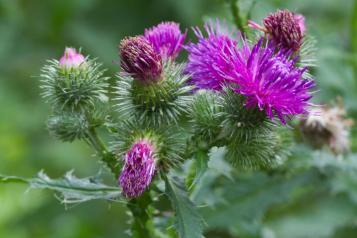
How to get rid of creeping thistle
- Dig up plants by hand, using a garden fork and taking care to get as much of the root as possible. Creeping thistles have long tap roots as well as lateral roots which break easily. Plants will grow back from root segments but will be weaker and easier to pull up.
- Cut young thistle seedlings off at ground level with a hoe.
- Deadhead thistles once flowers have started to develop. This weakens the plant, as it puts a lot of energy into producing the flowers.
Green alkanet
Green alkanet (Pentaglottis sempervirens) is a perennial garden weed that can be mistaken for a foxglove when the plants are small. Its large oval leaves look similar to foxglove leaves but are bristly to the touch and speckled with white spots. It produces small blue forget-me-not flowers in summer, and spreads rapidly by self-seeding. Although the flowers are attractive and good for pollinators, green alkanet takes up a lot of space in the border, crowding out other plants, so it should be kept under control.
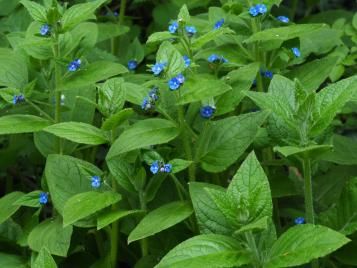
How to get rid of green alkanet
- Young seedlings can be easily dug up by hand with a hand fork.
- To dig up older, larger plants, use a garden fork and try to get the entire tap root out to stop the plant growing back.
- If it’s not possible to dig plants out, cut them down to ground level – this will gradually weaken the plant.
- Wear gloves when dealing with alkanet as the hairy stems and leaves can cause skin rashes.
Dock
Docks (Rumex ssp.) are perennial weeds with large oval leaves, often with distinct red or white mid-ribs. They have exceptionally long tap roots which can reach up to 90cm, but luckily, only the top 15cm or so of the root can regrow into new plant. Docks have long seedheads on tall stems and produce huge amounts of seed which can live in the soil for up to 50 years.
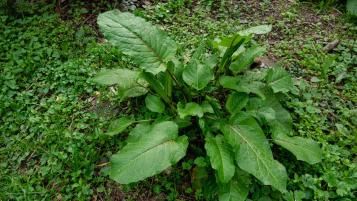
How to get rid of docks
- Dig up young dock plants as soon as you see them, as they are easier to get out when small. This is most effective in spring.
- Dig out large plants with garden fork, aiming to get as much of the root as possible.
- If hand weeding isn’t feasible, spray the plants in summer with a systemic weedkiller like Roundup Fast Action, which will kill the roots of the plant. Cover all surrounding plants with plastic sheeting to protect them from the spray.
Hedge bindweed
Bindweed (Calystegia sepium) is notorious for the way its thin climbing stems with their heart-shaped leaves twine around other plants, smothering them completely if left to grow unchecked. It produces large white trumpet-shaped flowers in summer. Bindweed spreads rapidly by underground rhizomes. It’s difficult to remove bindweed completely once established because the underground stems can be very deep, and plants will grow back from any segments left in the ground.
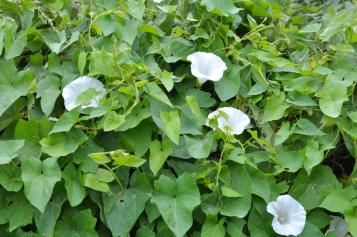
How to remove bindweed
- Pull up bindweed by hand whenever you see it, using a hand fork to dig up as much of the white root system as you can. This will weaken the plant, and in areas where it isn’t yet established, it may be enough to get rid of it altogether.
- If it’s not possible to dig up bindweed roots without disturbing other plants, use a hoe to sever the plant at root level.
- If bindweed can’t be controlled by hand, apply a systemic weedkiller like Roundup Fast Action to the leaves. This will eventually kill the roots of the plant. Cover all other nearby plants with plastic sheeting to protect them.
Couch grass
Couch grass (Elymus repens), also known as twitch grass, is a type of coarse perennial grass which is generally considered a weed. It has longer leaves than lawn grasses, and instead of clumps of fibrous roots, it produces a network of pale underground rhizomes which enable it to spread rapidly. Couch grass can be difficult to tackle in borders once established because it grows in amongst the roots of other plants and can regrow from any small segments of root left in the soil.
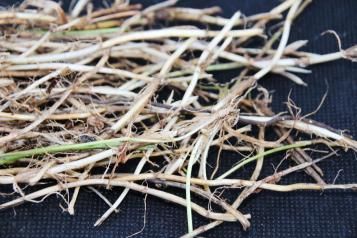
How to get rid of couch grass in borders
- Don’t dig over the soil in areas where couch grass is a problem, as this can break up the rhizomes, making the problem worse.
- Dig out individual plants in early spring using a hand fork, getting as much of the root out as possible.
- Clearing couch grass from established borders can be a long process. Dig up all the plants and check their rootballs, removing all segments of couch grass. Carefully remove all couch grass roots from the border soil before replanting.
- Dig out any new couch grass shoots as they appear.
Cleavers
Cleavers (Galium aparine) has many names, including goosegrass, sticky weed and sticky willie. This annual garden weed develops long sprawling stems with whorls of narrow leaves at intervals along each stem. Small white flowers in summer are followed by small round green or purple seeds. Stems, leaves and seeds are all covered in tiny, hooked bristles that attach to fur and clothing, allowing the seeds to be easily distributed around the garden. If left unchecked, cleavers can spread and smother other plants.
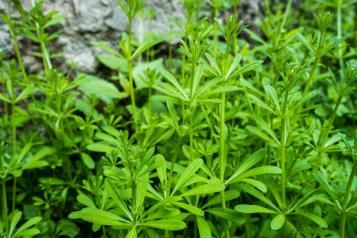
How to get rid of cleavers
- Cleavers has shallow roots and is easy to pull up by hand. A useful tip when tackling this weed is to roll it into balls as you pull it up – this makes the stems stick to each other rather than to your gloves! Avoid spreading any loose seeds that stick to clothing.
- Regular hoeing cuts off seedlings at the base before they can get established.
- Because cleavers tend to scramble through other plants, weedkiller is not practical for this weed.
Rosebay willowherb
Also known as fireweed, rosebay willowherb (Chamaenerion angustifolium) is a perennial weed producing tall stems with oval leaves and sprays of pink flowers in summer, followed by seed capsules that produce abundant fluffy seeds which are spread by the wind. Although it is very pretty, it self-seeds prolifically and also spreads via shallow, spreading roots.
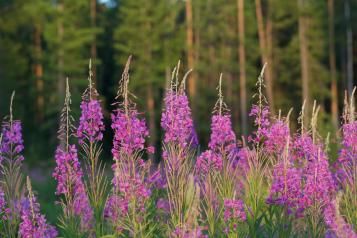
How to get rid of rosebay willowherb
- Rosebay willowherb is relatively easy to dig up with a garden fork or even a hand fork for smaller plants.
- Hoe borders regularly to cut down seedlings before they are big enough to be a problem.
Keep your lawn looking green, lush and weed free with our range of weed control products at Love The Garden.
